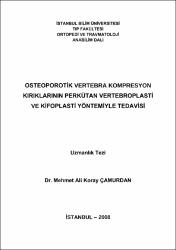Osteoporotik vertebra kompresyon kırıklarının perkütan vertebroplasti ve kifoplasti yöntemiyle tedavisi
Citation
Çamurdan, Mehmet Ali Koray. (2008). Osteoporotik Vertebra Kompresyon Kırıklarının Perkütan Vertebroplasti Ve Kifoplasti Yöntemiyle Tedavisi. Yayımlanmamış doktora tezi. İstanbul : İstanbul Bilim Üniversitesi, Tıp Fakültesi.Abstract
Vertebra kırıklarının tedavisinde konservatif ve cerrahi metodlar tek başına veya birlikte kullanılabilirken; tedavide amaç anatomik redüksiyon, spinal deformiteyi önlemek, ağrıyı azaltmak, vertebra yüksekliğini yeniden sağlamak stabil fiksasyon ve erken mobilizasyon ile hastanın günlük aktivitelerine geri dönmesini sağlamaktır. Bu tezde, kliniğimizde torakolomber osteoporotik vertebra kırıklarına endikasyon dahilinde uygulanan ve minimal invaziv bir yöntem olan perkütan vertebroplasti ve perkütan kifoplasti uygulamalarımızın sonuçları bildirilmiş ve literatür bilgileri ışığında tartışılmıştır.
Çalışmada 2003-2008 yılları arasında İstanbul Bilim Üniversitesi Ortopedi ve Travmatoloji Kliniği’nde akut ve subakut osteoporotik vertebra kompresyon kırığı tanısı ile perkütan vertebroplasti ve perkütan kifoplasti uygulanan toplam 148 hasta (498 vertebra) değerlendirmeye alındı. Tedavi öncesi yapılan fizik muayene değerlendirmelerinde olguların hiçbirinde nörolojik defisit saptanmadı. Olgular tedavi amacıyla kliniğe yatırıldıklarında Visual Analog Skala (VAS), Ağrı Dizabilite İndeksi (ADİ) ve Oswestry Dizabilite Sorgulaması (ODS) değerleri kaydedildi. Radyolojik tanıda olguların vertebral kolon ön-arka ve yan direkt grafileri rutin olarak değerlendirildi. Ağrısı olan ve direk grafide bulgu saptanan hastalarda manyetik rezonans görüntüleme (MRG) rutin olarak çekildi. Osteoporotik vertebra kompresyon kırığı tanısıyla olgulara çökme durumu değerlendirilerek perkütan vertebroplasti ve perkütan kifoplasti yapıldı. Olguların tümü ameliyat sonrası erken dönemde mobilize edildiler ve hiçbir hastaya korse uygulaması yapılmadı. Olgulara ameliyat sonrası dönemde osteoporoz ile ilgili medikal tedavi uygulandı.
Olgularımızın takip süresi ortalama 6 aydır. Olguların yaş ortalaması 74.70 olarak bulundu.(standart sapma 11.95). Erkeklerin yaş ortalaması 75.50 ve kadınların yaş ortalaması ise 74.42 şeklindeydi. Lezyonların 254’ü (%51,1) torakal, 244’ü (%48,9) lomber vertebrada lokalize idi. Hastalar kırık seviyelerine göre incelendiğinde; T1 1, T2 1, T3 3, T4 6, T5 9, T6 18, T7 23, T8 25, T9 22, T10 39, T11 42, T12 65, L1 51, L2 57, L3 50, L4 41, L5 34, S1 1 şeklinde gerçekleşti.
Osteoporotik vertebra kırıklarının daha sık görüldüğü yaşlı ve medikal komorbiditelerin varolduğu hastalarda perkütan vertebroplasti ve perkütan kifoplasti, minimal invasif bir cerrahi tedavi yöntemi olarak önemli bir yere sahiptir. Bu işlem ile cerrahi sırasında ve sonrasında çıkabilecek komplikasyonlar minimuma inmekte, kırık redüksiyonu ve ağrı giderimi sağlanmakta, hastaların hastane de yatış süreleri ve erken mobilizasyon süresi kısalmakta dolayısıyla sekonder hastalıklar kısmen önlenmektedir. Perkütan vertebroplasti ve perkütan kifoplasti işlemleri, osteoporotik vertebra kompresyon kırığını stabilize eden, ağrıyı maksimum düzeyde azaltan, vertebra duvar restorasyonu sağlayan, oluşabilecek spinal deformiteyi önleyen, kısa sürede mobilizasyon sağlayan ve hastanın normal yaşamına dönmesini kolaylaştıran ve böylelikle hastanın yaşam kalitesini artıran altın standart minimal invasif bir cerrahi tedavi yöntemidir.
İleri derecede osteoporotik hastalar sadece kırık seviyenin değil komşu segmentlerin profilaktik olarak vertebroplasti ile sementlenmesinden fayda görürler. Böylece ileride oluşabilecek refraktürlerin önüne geçilmiş ve hastaların hayat kalitesi arttırılmış olur. Treatment goals of osteoporotic vertebra compression fractures by both conservative and surgical measures are anatomic reduction, prevention of spinal deformity, cessation of pain, restoration of vertebral height and provision of daily living activities of patients by providing stable fixation and early mobilization. In the current study, we presented the clinical and radiological results of percutaneous vertebroplasty and balloon kyphoplasty which are minimally invasive surgical techniques and that was performed in thoracolumbar osteoporotic vertebra fractures in defined indications and discussed with the current literature.
We have evaluated 148 patients (498 vertebrae) who underwent percutaneous vertebroplasty and balloon kyphoplasty procedure due to acute and subacute osteoporotic vertebra fractures in İstanbul Bilim University Orthopedics and Traumatology Clinic between the years 2003 and 2008. The preoperative physical examination of the patients showed no neurological involvement. The preoperative Visual Analog Scale, Pain Disability Index and Oswestry Disability Questionaire values were recorded. The routine direct roentgenographies for evaluation of vertebral column from anteroposterior and lateral projections were also taken. In patients having pain and objective findings in the X-rays, magnetic resonance investigation of the spine was carried out routinely. Procedures were performed in patients with osteoporotic vertebra fractures. All cases were allowed to mobilize in the immediate postoperative period and no soft orthotics or any other device was prescribed. All patients also received medical treatment related with generalized osteoporosis.
The minimum follow-up period was 6 months. The mean age of the patients was 74.70 years (SD 11.95). Two hundred and fifty four procedures performed at thoracic (51.1%) region, two hundred and forty four (48.9%) procedures performed at lumbosakral region. The importance of minimally invasive surgeries is high in older patients with advanced medical illness in whom osteoporotic vertebral fractures are seen more frequently. By percutaneous vertebroplasty and percutaneous balloon kyphoplasty as a minimal invasive surgery, the rate of postoperative complications decrease, the fracture reduction and pain management are performed successfully, the hospitalization time and the time required for mobilization shortens so that secondary complications related with immobilization are diminished.
Moreover, if the patient have an excessive osteoporosis (t score <3.0), prophylactic vertebroplasty should be done in order to prevent further neighboring vertebral fractures.
In conclusion, percutaneous vertebroplasty and kyphoplasty are surgical treatments which stabilize the fracture, decrease the pain significantly, provide vertebral height restoration, prevents spinal deformity, makes the mobilization easier and quicker, and provides the patient to return normal daily living activities easily so that it improves the life standard of the patients suffering from osteoporotic vertebral fractures.


















